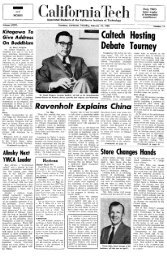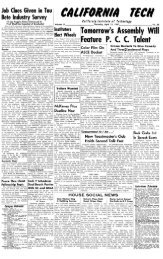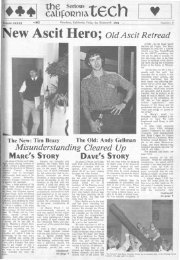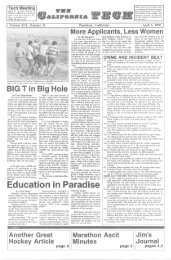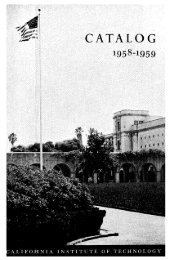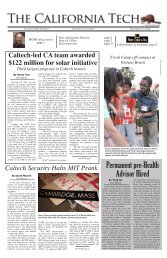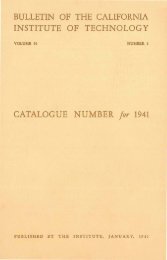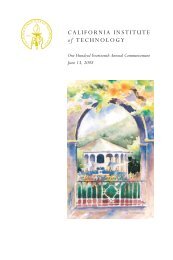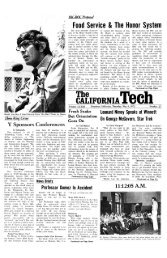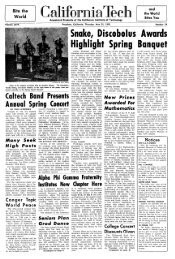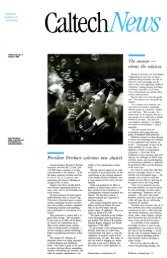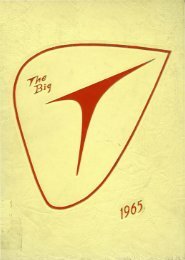CALTECH NEWS - CaltechCampusPubs
CALTECH NEWS - CaltechCampusPubs
CALTECH NEWS - CaltechCampusPubs
You also want an ePaper? Increase the reach of your titles
YUMPU automatically turns print PDFs into web optimized ePapers that Google loves.
Continued from page 1<br />
Archivist Judith Goodstein mines Caltech's history<br />
and the political and cultural background<br />
of the scientists," says Goodstein.<br />
"I really don't see the history of<br />
Cal tech as revealed in budgets, but I<br />
don't see it as exclusively a matter of<br />
pure scientific currents either. Science<br />
is a very human enterprise. You<br />
might call my approach 'science below<br />
the neck.'"<br />
Logistically speaking, Goodstein has<br />
been viewing science at Cal tech from<br />
the neck down since 1968, the year<br />
she descended into the basement of<br />
Millikan Library as Cal tech's first archivist.<br />
(She had arrived on campus<br />
two years earlier with her husband<br />
David Goodstein, now professor of<br />
physics and applied physics).<br />
Eighteen years later, she and her<br />
staff are still there, along with the<br />
more than 100 collections of faculty<br />
papers, and close to 70 oral histories<br />
that they have assembled and<br />
catalogued.<br />
Seen from below, or at least in the<br />
context of these unofficial documents,<br />
says Goodstein, some of<br />
Caltech's best known scientific accomplishments<br />
take on an entirely<br />
new dimension.<br />
For example, Beno Gutenberg, the<br />
European seismologist and computational<br />
theorist who contributed a key<br />
concept to the Richter scale, nearly<br />
didn't make it to Caltech at all. "We<br />
nearly lost Beno," says Goodstein,<br />
"because Millikan thought his salary<br />
demands were too high. It turned out<br />
Mrs. Gutenberg thought she would<br />
need to bring two household maids<br />
to the United States."<br />
(Without maids, but with plenty of<br />
advice from Millikan about the wonders<br />
of modem American appliances,<br />
Gutenberg arrived in 1930 and, with<br />
Richter, launched a revolution in the<br />
field of seismology.)<br />
And, several decades before he actually<br />
left, Goodstein adds, the Institute<br />
almost forfeited Linus Pauling.<br />
"Except that A. A. Noyes, who was<br />
chairman of the chemistry division,<br />
didn't tell Pauling that a Berkeley<br />
representative had come to campus<br />
to offer him an assistant<br />
professorship."<br />
Noyes's action-or lack of itmeant<br />
that Pauling was on the faculty<br />
in 1929 when geneticist Thomas<br />
Hunt Morgan gave a series of seminal<br />
lectures on his research group's work.<br />
Morgan and Pauling began a collaboration<br />
that grew into the field of<br />
molecular biology.<br />
For every Pauling or Morgan, says<br />
Goodstein, there are several less wellknown<br />
figures whose contributions<br />
George Ellery Hale is one of those whose<br />
name figures heavily in the early history<br />
of Caltech.<br />
name to Caltech's well-known<br />
lecture series.<br />
"Everyone on campus knows Watson's<br />
name, but almost no one realizes<br />
that for two decades he was<br />
literally Millikan's right-hand man.<br />
He came here to finish his PhD, fell<br />
under Millikan's spell, and devoted<br />
the years he would otherwise have<br />
spent building up his own career to<br />
building Caltech. Once Cal tech became<br />
successful, he was no longer<br />
needed. He never got his doctorate,<br />
so he had no scientific reputation to<br />
fall back on either. If you read his<br />
letters, you'll find that Earnest Watson<br />
died a sad, disillusioned<br />
old man."<br />
Another, much earlier, figure<br />
whom Goodstein briefly revives is<br />
Hilda Wood Grinnell, who earned a<br />
bachelor's degree in biology from<br />
Throop Polytechnic College in 1906.<br />
In 1910, then-President Scherer decided<br />
that Throop's recent change to<br />
a primarily engineering curriculum<br />
merited a change in admissions policy<br />
as well, and closed the Institute's<br />
doors to women.<br />
Fifty-two high ranking officers of the fleet inspected the laboratories at Caltech in 1934giving<br />
strong indication that the next war would be fought to a finish in the scientific<br />
research laboratories of the world. Robert A. Millikan (right) led the tour.<br />
to Cal tech have largely gone unnoticed.<br />
A major aim of her book is<br />
to redress the balance . "A lot of the<br />
work around here has been, and continues<br />
to be, carried out by people<br />
who never get the recognition that<br />
they deserve."<br />
One such individual, she says, was<br />
Earnest C. Watson, who gave his<br />
Not entirely forgotten, Cal tech's<br />
"first" woman graduate can still be<br />
read as co-author (with her husband)<br />
of a 1907 Bulletin of Throop Institute<br />
entitled "Reptiles of L. A. County."<br />
"Scherer made the decision to restrict<br />
Throop to men without consulting<br />
anybody," says Goodstein. "It's<br />
worth speculating about what might<br />
have happened if Cal tech, like MIT,<br />
had remained a coed institution."<br />
Scherer's action, she adds, also<br />
raises questions about the wisdom of<br />
administrators who make unilateral<br />
decisions. without adequately considering<br />
the consequences.<br />
It doesn't bother Goodstein that<br />
her book is unlikely to make the bestseller<br />
lists- unless it's one that's made<br />
up mostly of Caltech alumni. It also<br />
doesn't concern her that many of her<br />
scientific colleagues undoubtedly<br />
view history-and the history of<br />
JlI took it upon myself to<br />
discourage the women applicants<br />
because there were so few,<br />
and it wouldn't have been fair<br />
to them."<br />
Throop President, A. B. Scherer<br />
science in particular- with the skeptical<br />
eye they reserve for uncontrolled<br />
experiments.<br />
"In a fundamental way, Cal tech is<br />
its history," she says. "It's hard to<br />
think of a single major challenge facing<br />
the Institute today that doesn't<br />
have its roots or a parallel in<br />
Cal tech's past. Cal tech's rise is also a<br />
unique and remarkable story. Look<br />
at Caltech's founder George Ellery<br />
Hale. He was an astronomer, but he's<br />
also been called a thinking man's P. T.<br />
Barnum. He was determined to create<br />
a training ground and reservoir of<br />
scientific talent for the entire world.<br />
And he succeeded."<br />
Talking to Goodstein about the<br />
Institute's history, it becomes evident<br />
that Hale, who also founded nearby<br />
Mount Wilson Observatory; left a<br />
legacy of two expanding universes.<br />
One was discovered in 1929 by<br />
Edwin Hubble, using Mount Wilson's<br />
100-inch telescope. The other was<br />
Caltech.<br />
As a historian, of course,<br />
Goodstein can only speculate about<br />
how Hale's second universe will<br />
continue to unfold. But after six<br />
years devoted to investigating<br />
Caltech's past, she may have arrived<br />
"I have noticed a report in<br />
'Science Service' that Lauritsen<br />
has produced neutrons, and the<br />
usual Caltech ballyhoo is set<br />
forth regarding his being the first<br />
in the country, etc., to do it."<br />
Berkeley physicist, Ernest<br />
Lawrence, from a letter<br />
at the best view of at least one aspect<br />
of the Institute's future:<br />
"The scientists at Cal tech will<br />
always have the first say," she says.<br />
"But in the end, as always, it's the<br />
historians who will have the last<br />
word."



